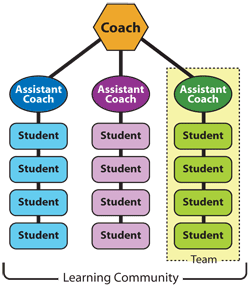
Learning Community Structure
A learning to learn camp is designed to accommodate up to 100 students. The facilitation team for a camp consists of a lead facilitator from Pacific Crest and two or three co-facilitators from the host institution who will be trained to lead future camps.
In addition, there are a group of coaches who are responsible for 12-15 students who comprise a "learning community" (within the structure of the entire camp community). Each coach has 3-5 assistant coaches who are responsible for a "team" of three or four students.

For example, a camp of 60 students would have a facilitation team of three (a lead facilitator from Pacific Crest and two co-facilitators) along with five coaches who would each be responsible for a learning community of twelve students.
These learning communities would each have three assistant coaches who would each work with a learning team of four students. In total, there would be a facilitation team of three, five coaches and fifteen assistant coaches. This ratio of three students to one coach is desired. Coaches are mostly from the host institution but Pacific Crest can assist with recruiting coaches from other institutions as needed.
In this type of environment, learners can expect to receive continuous mentoring from coaches. At the same time a peer coaching system helps support the development of facilitation skills among the coaches. Also, the facilitator will provide feedback to coaches with respect their performance at mentoring student growth.
The facilitator will work with the co-facilitators to help train them to facilitate future camps; in a "train the trainers" manner. It is recommended that coaches have previously attended a Teaching Institute.
Below are descriptions of the
responsibilities for the facilitator and coaches.
Facilitator
Coach
Assistant coach